While Denali is worth visiting on the basis of its scenery alone, it’s the wildlife that will truly shape your experience. In the summer, Denali is host to some eight species of medium to large sized mammals, including foxes, lynx, wolves, grizzly bears, black bears, caribou, Dall sheep and moose. Among those, the moose, grizzly bear, caribou, wolf, and Dall sheep make up what’s known as the “Denali Big 5.”
Seeing wildlife in Denali is mostly about luck and timing, but the longer you’re in the park the more chances you have to view wildlife. As I described in my earlier post, I scheduled and bus hopped my trips in such a way that I stayed in the park most of the day. This is particularly important for moose, which are generally crepuscular, meaning they are more active in the morning and evening . Everything else is really just a gamble. Sometimes the odds are in your favor and sometimes they’re not. For what it’s worth, though, out of my four all-day trips into the park I got The Big 5 twice, both during the times I stayed primarily on the bus.
While I always left the park having experienced something new, there were definitely trips that were more memorable than others, and the range of experiences really made me appreciate the luxury of being able to go multiple times. Whatever wildlife you do have the privilege of encountering is sure to fan the flames of your love affair with this park, but I imagine for many people that affair starts first and foremost with the most visible and charismatic of Denali’s wildlife: The grizzly bears.
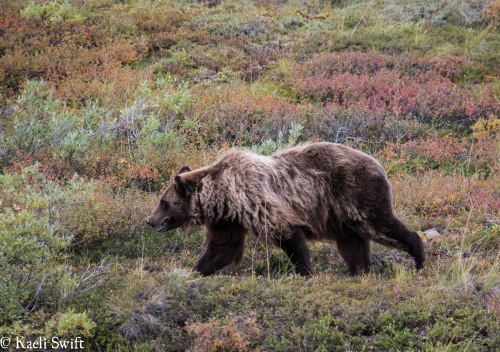
I took this photo in late August, just as the colors started to change.
By late July, bears across Alaska are gearing up for hibernation by entering a phase called hyperphagia, where they basically eat constantly and gain somewhere on the order of 400 pounds. In the park, their diet consists mostly of blueberries, soapberries, and roots, but they will gladly eat whatever mammals they can catch, including small rodents, caribou, moose and even other bears.
A big highlight when bear watching is seeing sows out with spring cubs. Unlike mom, the young are generally a lot darker in color, prompting people to sometimes mistake them as black bears. Observing cubs playing, foraging, and trying to keep up with mom is definitely the kind of experience that will make you wonder if you were somehow transported, Truman style, to some kind of nature documentary, but in the best kind of way.

While I won’t pretend for a second that seeing bears ever gets old, they honestly weren’t the animal that I was most looking forward to encountering when I arrived in Denali. Maybe it’s because I’d never seen one before, or because of some deep affection instilled by decades of Christmas marketing, but something about caribou utterly charms me.
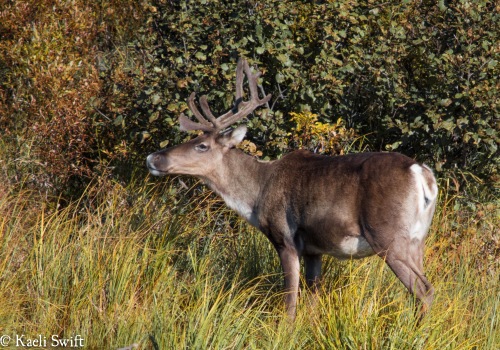
Unlike many of Alaska’s other herds, the Denali caribou do not undertake an immense seasonal migration, opting instead to remain almost exclusively within the bounds of the park year round. Unless you can travel into the interior of the park, however, you’ll have little luck seeing them in the winter.
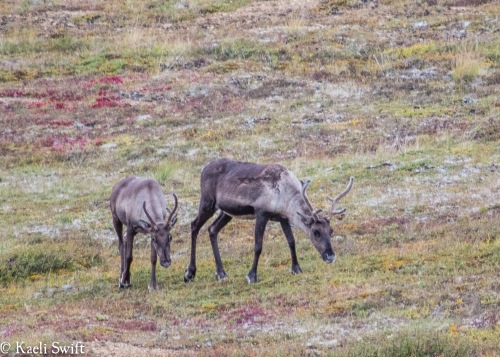
Denali used to play host to a herd that ranged in the tens of thousands, but after decades of over hunting followed by a mysterious period of low calf survival and harsh winters, Denali’s herd has dwindled to around 2,000 individuals. Fortunately, things seem to have stabilized for the time being. I wish I had seen more before the end of the season, but I’ll never forget what it was like watching this small herd move through this painted hillside.
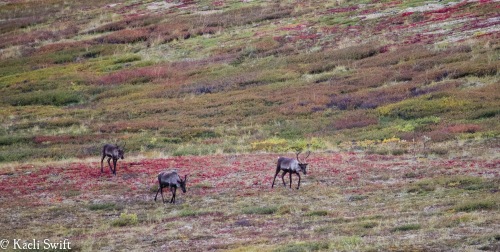
The ungulates that seemed to most delight my fellow visitors, however, were the moose. For all of Denali’s hooved animals fall is the rut, which means males have grown out their antlers or horns and are putting them to use in sparring (practice) matches, as they ready themselves for the violent matches to come. I only saw such behavior between moose once. They locked antlers for a few seconds and went back to grazing shortly thereafter. Unfortunately it was too far away to bother with any photos. I’ll admit, seeing a bull moose, particularly on foot, is a gripping experience. However big you imagine them to be, they’re bigger in person. The rack alone can be 40lbs.

In Denali, the stakes of these fights are high, as the moose here operate in a polygynous system, where the victor will mate with and defend an entire heard of females. In other places, moose form monogamous pairs for the breeding season.
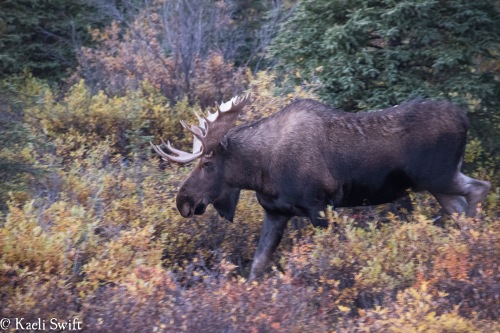
It was early morning still when we watched this cow move her two calves across the valley. They seemed pretty wary of our bus, though her biggest real threat is the park’s main carnivorous predator: The gray wolf.
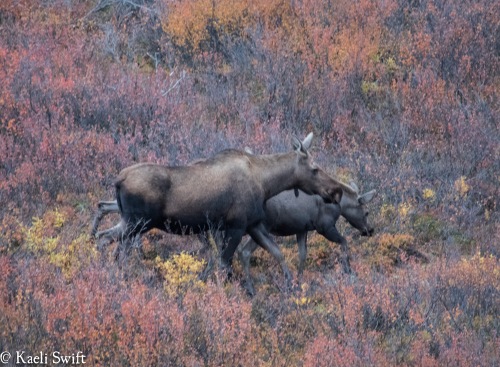
Even in Yellowstone I don’t get my hopes up about seeing wolves despite there being far more individuals there. Across the Denali’s 6 million acres, there are only 30 known packs comprising about 75 adults. You can imagine my delight then, when, as we were making our way out of the park at dusk on our first trip, we rounded a corner to see this rump trotting up ahead of us. As it happens, I had been walking the road on foot only minutes before. I probably wouldn’t have caught up with it had I not gotten on the bus, but it’s still pretty incredible to imagine that I more or less went hiking with a wolf. We must have followed this adult for about a mile. It stopped a few times, evening giving it’s signature mournful howl a before it disappeared off the side of the road. Honestly, that would have been enough for me, but our second to last trip had something really special in store.
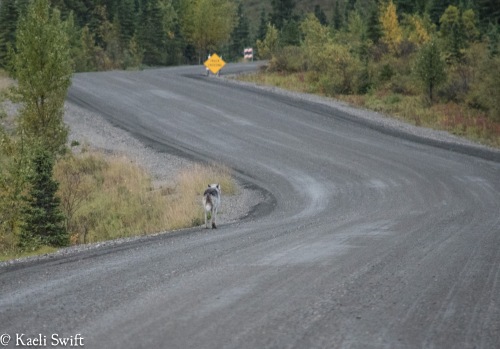
I had heard whispering about wolf pups back at our housing campus but I never thought much of it. I figured that was deep interior kind of stuff, the kind of trek our field schedule just wouldn’t permit. So while I figured it was something exciting when we arrived at a jam packed road, I just wasn’t picturing this…
Cue total F-ing meltdown on my part.
This pup was born sometime mid-may to the single male and female that comprise the Riley Creek West pack. By around four months the pups start venturing away from their den site. Lucky for us, for a few day stretch the area they were exploring was right near the road by Toklat. After a few days, they moved away from the road, which was no doubt for the best.
The last animal I have the great pleasure to highlight is the most iconic of Denali’s wildlife. In fact, it was this animal for whom the park was dedicated. The endemic Dall sheep.

In 1906, hunter and conservationist Charles Sheldon noticed a worrying decline in the Dall sheep favored by hunters. He feared that without protection, they would be hunted to extinction. Now this is an all too familiar concept, but coming off the heels of the “era of abundance” this was actually a revolutionary way of thinking in western culture. Until 1900, colonists/settlers in the United Stated hunted without regulation and, seemingly, without much thought or worry as to the integrity of ecosystems. As a frame of reference, the field of wildlife management wouldn’t come onto the scene for another two decades.
Sheldon, however, had the foresight to recognize that something must be done and set out to establish Denali as a national park. It took 11 years, but in 1917 Woodrow Wilson signed the bill into law. Since that time Dall sheep populations rebounded and are currently considered healthy.
Despite their robust numbers, however, most of my experiences of seeing Dall sheep in the park were “technical”. As in, “technically those white specks on the mountain side are Dall sheep”. So on our last day as we traveled out of the park, I couldn’t believe my eyes when a ewe and her lamb were jogging down a hillside close enough that you could judge their forms as Dall sheep even with your naked eye. For the minute or so that we were able to watch them, I felt myself overcome with equal parts joy and despair. I was profoundly grateful for the gift of such beauty and yet so sad that once again its integrity is under such threat.

Driving home one night, my fellow passengers and I shared our backgrounds and motivations for visiting the park. Some came to experience mammals the size of which dwarfs anything in their native country, some were fulfilling missions to visit all the National Parks, while others had arrived with a spirit of adventure and little else. Together, we marveled at the unforgettable things we had seen and shared our anxieties that future generations may not be so lucky. We discussed our anger and disappointment (or among some of the foreign tourists utter bafflement) at the US government’s unwillingness to act more effectively on climate change.
One hundred years ago someone looked at this land, recognized that change must be implemented, and fought for over a decade to convince congress that in fact wild spaces and wildlife mattered enough to act. As a result, my fellow passengers and I got to see and experience things that will bring us joy the rest of our lives. The question now is whether we will wage our own fight for the future, or if we will watch from the sidelines as it turns to ash in our warming world.
***

For information about climate change in the arctic please visit the following resources
NASA’s Arctic-Boreal Vulnerability Experiment
The National Snow and Ice Data Center
And remember…
~PLEASE VOTE ON NOV 6TH~











Thank you for taking the time to share these experiences. Also, look at those big feet on the wolf cub.
Aren’t they so cute?
plop plop plop plop on down the road.
I am in Australia, will never get to Denali so I just love love love your blog. Thankyou! (Also your politics baffles me too.) Judith
Thanks so much Judith! It’s those kinds of comments that keep me writing and sharing 🙂
Excellent article. Thanks for sharing your experiences.
Always passionate and interesting, thank you 🙂 I send you a Swedish crow from yesterday… Erik
Thank you for your sensitivity and insight. The color in all these photos is stunning. Wild babies always unstitch me. I so appreciate your blogs. I hope you keep at them for a while….
… GRAA (“great reading, as always”), and thanks for “wanting” to share; I’m thinking it’s wanting that turns teachers into the action heroes we’re seeing, now, in movies